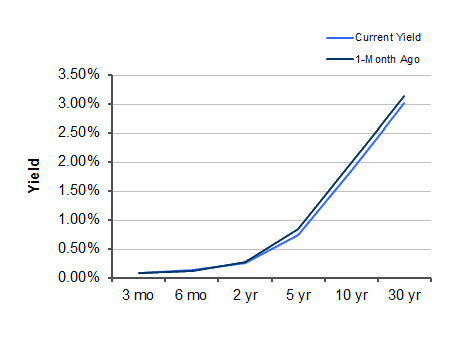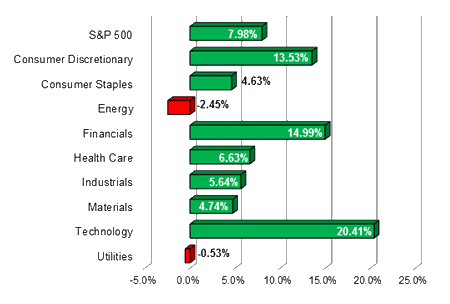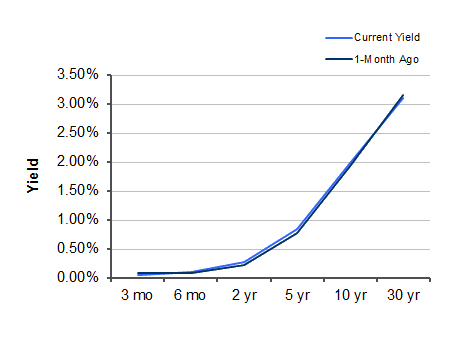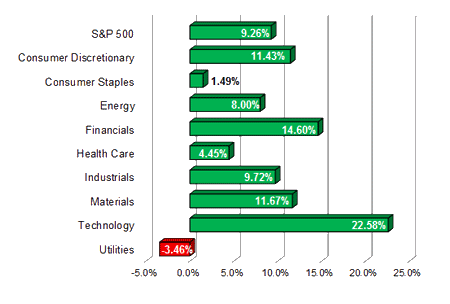The Weekly Market Snapshot from Frazier Allen for the week of May 27th, 2012
May 27, 2012

Market Commentary by Scott J. Brown, Ph.D., Chief Economist
The news out of Europe remained bleak. G-8 leaders committed “to take all necessary steps” to strengthen and reinvigorate their economies, but recognized that “the right measures are not the same for each of us.” A few days later, European Union leaders could not agree on a course of action. Manufacturing sentiment surveys were weak in China and the eurozone (including France and Germany).
How much bad news (about Europe) is factored in? Apparently a lot. The markets reacted only briefly and modestly to Europe’s bad news, although there was plenty of intraday volatility along the way.
The U.S. economic calendar was relatively thin, with improvement in both new and existing home sales, but disappointing figures on durable goods orders. Consumer sentiment improved (for the ninth consecutive month) to its highest level since October 2007, largely due to more favorable job and wage prospects. [Read more]
The Weekly Market Snapshot from Frazier Allen for the week of May 20th, 2012
May 20, 2012

Market Commentary by Scott J. Brown, Ph.D., Chief Economist

Scott J. Brown Ph.D., Chief Economist Raymond James Investment Services
The economic data were mixed, but mostly on the soft side of expectations. Retail sales were a bit weaker than expected in April. Industrial production improved, but partly reflected a surge in the output of utilities (more normal weather). Residential construction figures showed a moderate trend of improvement (from very low levels) in single-family homebuilding.
The minutes of the April 24th-25th monetary policy meeting showed that Fed officials were worried about the downside risks to growth from Europe and the potential for significantly tighter fiscal policy in the U.S. Fed officials were open to doing more (QE3), but only if the economic recovery were to lose momentum or downside risks intensified.
Greece was unable to form a coalition to run the government and so will have another set of elections on June 17th. [Read more]
The Weekly Market Snapshot from Frazier Allen for the week of May 13th, 2012
May 12, 2012

Market Commentary by Scott J. Brown, Ph.D., Chief Economist

Scott J. Brown Ph.D., Chief Economist Raymond James Investment Services
Europe, again. Election results in France and Greece were not a surprise, but they added to concerns about the European crisis. The important aspect, for U.S. investors, is the uncertainty. Nobody knows exactly what will happen in Europe, but few doubt that the situation will be resolved anytime soon.
The second bailout agreement for Greece was only a few months ago, but at the time many felt that Greece would never be able to live up to the requirements.
Elsewhere in Europe, there has been some backsliding on austerity. Tighter budgets have weakened the troubled economies in Europe and have done nothing to resolve financial difficulties. Austerity is needed in the long term, but what’s needed in the short term is economic growth.
The economic calendar was thin. The trade deficit widened more than most analysts expected, but figures were only slightly wider than what was assumed in the advance GDP report.
Jobless claims appear to have settled down (at nearly the same pace as in March) after seasonal adjustment quirks lifted the figures in the first three weeks of April. Consumer sentiment improved in the mid-May assessment.
Next week, Europe is expected to be an ongoing concern for U.S. investors, but the arrival of mid-month economic data will provide a distraction. The focus is likely to be on the retail sales and residential construction reports. April’s retail sales are likely to have been moderate. April building permits and housing starts are expected to reflect an unwinding of the multi-family noise from March (single-family construction appears to have turned the corner, but a full recovery in housing is years away). The FOMC policy meeting minutes could include some market-moving quotes.
Indices
| Last | Last Week | YTD return % | |
| DJIA | 12855.04 | 13206.59 | 5.22% |
| NASDAQ | 2933.64 | 3024.30 | 12.61% |
| S&P 500 | 1357.99 | 1391.57 | 7.98% |
| MSCI EAFE | 1446.19 | 1503.67 | 2.38% |
| Russell 2000 | 791.75 | 806.59 | 6.86% |
Consumer Money Rates
| Last | 1-year ago | |
| Prime Rate | 3.25 | 3.25 |
| Fed Funds | 0.16 | 0.08 |
| 30-year mortgage | 3.78 | 4.59 |
Currencies
| Last | 1-year ago | |
| Dollars per British Pound | 1.616 | 1.633 |
| Dollars per Euro | 1.296 | 1.436 |
| Japanese Yen per Dollar | 79.960 | 80.720 |
| Canadian Dollars per Dollar | 1.000 | 0.961 |
| Mexican Peso per Dollar | 13.446 | 11.593 |
Commodities
| Last | 1-year ago | |
| Crude Oil | 97.08 | 103.88 |
| Gold | 1596.25 | 1516.05 |
Bond Rates
| Last | 1-month ago | |
| 2-year treasury | 0.26 | 0.27 |
| 10-year treasury | 1.85 | 1.99 |
| 10-year municipal (TEY) | 1.76 | 1.97 |
Treasury Yield Curve – 5/11/2012
S&P Sector Performance (YTD) – 5/11/2012
Economic Calendar
| May 15th |
— |
Consumer Price Index (April) Retail Sales (April) Empire State Manufacturing Index (May) Business Inventories (March) Homebuilder Sentiment (May) |
| May 16th |
— |
Building Permits, Housing Starts (April) Industrial Production (April) FOMC Minutes (April 24-25) |
| May 17th |
— |
Jobless Claims (week ending May 12th) Philadelphia Fed Index (May) Leading Economic Indicators (April) |
| May 22nd |
— |
Existing Home Sales (April) |
| May 23rd |
— |
New Home Sales (April) |
| May 24th |
— |
Durable Goods Orders (April) |
| May 28th |
— |
Memorial Day Holiday (markets closed) |
| June 1st |
— |
Employment Report (May) |
| June 20th |
— |
FOMC Policy Decision Bernanke Press Briefing |
Important Disclosures
US government bonds and treasury bills are guaranteed by the US government and, if held to maturity, offer a fixed rate of return and guaranteed principal value. US government bonds are issued and guaranteed as to the timely payment of principal and interest by the federal government. Treasury bills are certificates reflecting short-term (less than one year) obligations of the US government.
Commodities trading is generally considered speculative because of the significant potential for investment loss. Markets for commodities are likely to be volatile and there may be sharp price fluctuations even during periods when prices overall are rising. Specific sector investing can be subject to different and greater risks than more diversified investments.
Tax Equiv Muni yields (TEY) assume a 35% tax rate on triple-A rated, tax-exempt insured revenue bonds.
![]() Material prepared by Raymond James for use by its financial advisors.
Material prepared by Raymond James for use by its financial advisors.
The information contained herein has been obtained from sources considered reliable, but we do not guarantee that the foregoing material is accurate or complete. Data source: Bloomberg, as of close of business April 26th, 2012.
©2012 Raymond James Financial Services, Inc. member FINRA / SIPC.
The Weekly Market Snapshot from Frazier Allen for the week of April 29th, 2012
April 29, 2012

Market Commentary by Scott J. Brown, Ph.D., Chief Economist

Scott J. Brown Ph.D., Chief Economist Raymond James Investment Services
As expected, the Federal Open Market Committee left short-term interest rates unchanged and refrained from additional asset purchases. The Fed still expects that “economic conditions – including low rates of resource utilization and a subdued outlook for inflation over the medium run – are likely to warrant exceptionally low levels for the federal funds rate at least through late 2014.”However, officials were still divided on when they thought it would be appropriate to start tightening. Officials revised higher their projections for 2012 GDP growth, but slightly lower their growth expectations for 2013 and 2014.
Real GDP rose at a 2.2% annual rate in the advance estimate for 1Q12, below the +2.5% median forecast. The details were a mixed bag. Consumer spending rose at a 2.9% annual rate, led by a sharp increase in motor vehicles. Business fixed investment fell at a 2.1% pace (structures down 12.0%, equipment and software up 1.7%). [Read more]
The Weekly Market Snapshot from Frazier Allen for the week of April 22nd, 2012
April 22, 2012

Market Commentary by Scott J. Brown, Ph.D., Chief Economist

Scott J. Brown Ph.D., Chief Economist Raymond James Investment Services
Europe remained a key concern for U.S. investors. Spain’s debt auction went better than feared. Global investors expressed some concerns about France’s election (first round on April 22nd, second round on May 6th). In its World Economic Outlook, the IMF revised its outlook for global growth slightly higher, but cautioned that “recent improvements are very fragile.”
The U.S. economic data were mixed. Retail sales were stronger than expected in March. Existing home sales and industrial production were weaker than anticipated. Residential construction figures were mixed (permits up, starts down), but first quarter figures were stronger than a year ago (likely aided by a mild winter). Weekly jobless claims were higher than expected, but seasonal adjustment at the start of the quarter is difficult, making recent figures appear suspect. [Read more]
The Weekly Market Snapshot from Frazier Allen for the week of April 15th, 2012
April 15, 2012

Market Commentary by Scott J. Brown, Ph.D., Chief Economist

Scott J. Brown Ph.D., Chief Economist Raymond James Investment Services
The stock market began the week with a (negative) reaction to the March Employment Report (which was softer than expected, but not terrible). Worries about Europe and global growth also weighed against market sentiment – the fear subsided a bit on Wednesday and Thursday, but appeared to return on Friday. Fed officials suggest that monetary policy was conditional on how the economy develops – although no action is expected anytime soon.
The economic data remained consistent with moderate growth and moderate inflation. As expected, the seasonal adjustment dampened the impact of higher gasoline prices in the Consumer Price Index. The core CPI rose 2.3% y/y. The Fed’s Beige Book noted “modest to moderate” economic growth. [Read more]
The Weekly Market Snapshot from Frazier Allen for the week of April 10th, 2012
April 10, 2012

Market Commentary by Scott J. Brown, Ph.D., Chief Economist

Scott J. Brown Ph.D., Chief Economist Raymond James Investment Services
The minutes of the March 13 Federal Open Market Committee meeting suggested reduced odds of another round of Fed asset purchases (QE3). That shouldn’t have been a surprise to anyone, but the news was taken negatively by the stock market and long-term Treasury yields snapped higher. The European Central Bank left rates changed, but ECP president Draghi seemed a bit hawkish in his post-meeting press conference, renewing concerns about the European financial crisis (I guess, it wouldn’t seem like spring otherwise).
The U.S. economic data (this is being written before the release of the March Employment Report) remained consistent with moderate growth. ISM figures were mixed, but both reports showed further growth in new orders and employment. [Read more]
The Weekly Market Snapshot from Frazier Allen for the week of April 1st, 2012
April 1, 2012

Market Commentary by Scott J. Brown, Ph.D., Chief Economist

Scott J. Brown Ph.D., Chief Economist Raymond James Investment Services
The week began with a speech by Fed Chairman Bernanke, where he noted that “further significant improvements in the unemployment rate will likely require a more-rapid expansion of production and demand from consumers and businesses, a process that can be supported by continued accommodative policies.”Many interpreted this to mean that further asset purchases (QE3) were still on the table (if somewhat unlikely). Concerns about softer global growth seemed to weigh against equity market sentiment through the middle of the week. Quarter-end likely window-dressing added a bit to market volatility. Bond yields fell.
The economic data reports were mixed. The personal income and spending figures were probably the most important, but were not fully appreciated by the markets. [Read more]
The Weekly Market Snapshot from Frazier Allen for the week of March 11th, 2012
March 11, 2012

Market Commentary by Scott J. Brown, Ph.D., Chief Economist

Scott J. Brown Ph.D., Chief Economist Raymond James Investment Services
Worries about the Greek debt swap agreement weighed against global stock markets earlier in the week, but confidence returned as the Greek deal looked like it would succeed. The February job market figures were strong, a positive for equities and a negative for bonds, but most of that news was already factored in.
Nonfarm payrolls rose by 227,000 in February, while the two previous months were revised a net 61,000 higher (leaving the three-month average at 245,000). The unemployment rate held steady at 8.3%, but that was despite an increase in labor force participation (which rose from 63.7% to 63.9%). The employment-to-population ratio edged up to 58.6%, vs. 58.5% in January and 58.4% in December. It’s likely that the unusually mild winter had a significant impact on payrolls, hours, and labor force participation. [Read more]
The Weekly Market Snapshot from Frazier Allen for the week of March 4th, 2012
March 4, 2012

Market Commentary by Scott J. Brown, Ph.D., Chief Economist

Scott J. Brown Ph.D., Chief Economist Raymond James Investment Services
The economic data reports were mixed. Real GDP rose at a 3.0% annual rate in the 2nd estimate for 4Q11 (vs. +2.8% in the advance estimate), with slight upward revisions to consumer spending and business fixed investment. The details of the report showed a significant upward revision to estimates of personal income for both 3Q11 and 4Q11 (that news, suggesting that the trend in income wasn’t especially strong, but a lot less weak than previously estimated, went largely unnoticed by the markets).
Consumer spending was softer than expected in February, held down partly by a weather-related decrease in energy consumption (ex-energy, spending rose 0.4%). Still, adjusted for inflation, consumer spending was flat for the third consecutive month in January. Since consumer spending accounts for 70% of overall GDP, these data suggest that first quarter growth may be a lot weaker than was hoped for earlier.
Unit auto sales jumped to a 15.0 million seasonally adjusted annual rate in February, up from 14.1 million in January and 13.0 million a year ago. The February ISM Manufacturing Index fell. Consumer confidence improved, but the survey missed much of the recent increase in gasoline prices.
In his semi-annual testimony on monetary policy, Fed Chairman Bernanke said that recent information “is consistent with growth proceeding, in coming quarters, at a pace close to or somewhat above the pace that was registered during the second half of last year (about 2¼%).” Bernanke noted that “continued improvement in the job market is likely to require stronger growth in final demand and production” and added that “strains in global financial markets pose significant downside risks to the economic outlook.” However, the markets focused on what he didn’t say – that is, there was no hint of further asset purchases in the near term.
Next week, the focus is expected to be on Friday’s job market report. Seasonal adjustment will remain an important factor in February, adding, along with the weather, considerable uncertainty to the payroll estimate. However, it’s unclear whether mild weather has pulled forward gains that normally would have occurred in March and April (as is often the case). More troublesome, high gasoline prices, if sustained, are likely to dampen the pace of hiring for smaller firms.
Indices
| Last | Last Week | YTD return % | |
| DJIA | 12980.30 | 12984.69 | 6.24% |
| NASDAQ | 2988.97 | 2956.98 | 14.73% |
| S&P 500 | 1374.09 | 1363.46 | 9.26% |
| MSCI EAFE | 1570.58 | 1559.01 | 11.19% |
| Russell 2000 | 815.22 | 829.23 | 10.03% |
Consumer Money Rates
| Last | 1-year ago | |
| Prime Rate | 3.25 | 3.25 |
| Fed Funds | 0.12 | 0.16 |
| 30-year mortgage | 3.93 | 4.83 |
Currencies
| Last | 1-year ago | |
| Dollars per British Pound | 1.595 | 1.628 |
| Dollars per Euro | 1.332 | 1.381 |
| Japanese Yen per Dollar | 81.140 | 81.860 |
| Canadian Dollars per Dollar | 0.985 | 0.974 |
| Mexican Peso per Dollar | 12.739 | 12.094 |
Commodities
| Last | 1-year ago | |
| Crude Oil | 108.84 | 99.63 |
| Gold | 1717.68 | 1428.55 |
Bond Rates
| Last | 1-month ago | |
| 2-year treasury | 0.27 | 0.23 |
| 10-year treasury | 1.98 | 1.93 |
| 10-year municipal (TEY) | 2.93 | 2.66 |
Treasury Yield Curve – 3/02/2012
S&P Sector Performance (YTD) – 3/02/2012
Economic Calendar
| March 5th |
— |
ISM Non-Manufacturing Index (February) |
| March 7th |
— |
ADP Payroll Estimate (February) |
| March 8th |
— |
Jobless Claims (week ending March 3rd) |
| March 9th |
— |
Employment Report (February) |
| March 13th |
— |
Retail Sales (February) FOMC Policy Decision (no press briefing) |
| March 16th |
— |
Consumer Price Index (February) |
| April 6th |
— |
Good Friday (stock market closed, bonds open half a day) Employment Report (March) |
| April 25th |
— |
FOMC Policy Decision Bernanke Press Briefing |
Important Disclosures
US government bonds and treasury bills are guaranteed by the US government and, if held to maturity, offer a fixed rate of return and guaranteed principal value. US government bonds are issued and guaranteed as to the timely payment of principal and interest by the federal government. Treasury bills are certificates reflecting short-term (less than one year) obligations of the US government.
Commodities trading is generally considered speculative because of the significant potential for investment loss. Markets for commodities are likely to be volatile and there may be sharp price fluctuations even during periods when prices overall are rising. Specific sector investing can be subject to different and greater risks than more diversified investments.
Tax Equiv Muni yields (TEY) assume a 35% tax rate on triple-A rated, tax-exempt insured revenue bonds.
![]() Material prepared by Raymond James for use by its financial advisors.
Material prepared by Raymond James for use by its financial advisors.
The information contained herein has been obtained from sources considered reliable, but we do not guarantee that the foregoing material is accurate or complete. Data source: Bloomberg, as of close of business March 1st, 2012.
©2012 Raymond James Financial Services, Inc. member FINRA / SIPC.











